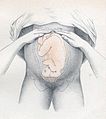Leopold handles
The Leopold handles , named after the gynecologist Christian Leopold (1846–1911), are part of the physical examination of a woman during pregnancy . In combination with other clinical and technical examinations (e.g. vaginal examination, sonography ), they are used to estimate the timely development of pregnancy and to determine the position of the fetus in the womb. All Leopold hand movements represent a palpation through the abdominal wall and are carried out on the patient lying on her back.
1. Leopold handle: determining the position of the fundus
Beginning at the costal arch, try to feel the fundus position of the uterus with the edges of both hands . The position of the fetus can be determined later in pregnancy (late second and third trimester ). So z. B. feel the head of the child in the fundus in breech position .
2. Leopold handle: position of the back and the small parts
To determine the position of the child's back, the hands are placed on the left and right of the palpable uterus. With light pressure, arms and legs ( small parts ) can be felt on one side and the back on the other.
- I means: back is on the left (as seen from the woman),
- II means: back is on the right.
- I, IIa each mean: forward tendency,
- I / IIb trend backwards accordingly.
In the transverse position, this refers to the position of the child's head.
3. Leopold handle: Determination of the previous part
It is used to determine the position of the fetus, i.e. whether the patient is in a breech position or in a breech position . To do this, the examiner places his hand above the symphysis and tries to push the child's skull back and forth with his thumb and forefinger ('balloting'). If the child lies in breech position, this is not possible.
4. Leopold handle: Determination of the setting
It is used to feel the setting ( i.e. the positional relationship of the preceding part to the pelvic entrance) of the child after it has already entered the pelvis. The examiner slowly lets his fingertips slide into the pelvis , coming from laterally above, parallel to the groin over the abdominal wall. In this way, the type (head or legs) and position of the preceding part in relation to the pelvic entrance can be assessed.
5. Leopold handle / Zangemeister handle: Exclusion of a disproportion between pelvis and head
(also: Zangemeister handle , named after Wilhelm Zangemeister )
The Zangemeister handle is used during birth to prove a disproportion between the mother's pelvis and the child's head, e.g. B. with a high straight position. To do this, the examiner places one hand on the symphysis and the other cranially on the part of the child that precedes it. The cranial hand should be at a lower level than the caudal (the maternal pelvis should protrude above the child's head). If this is not the case, it directs the suspicion of a disproportion between the pelvis and the child.



